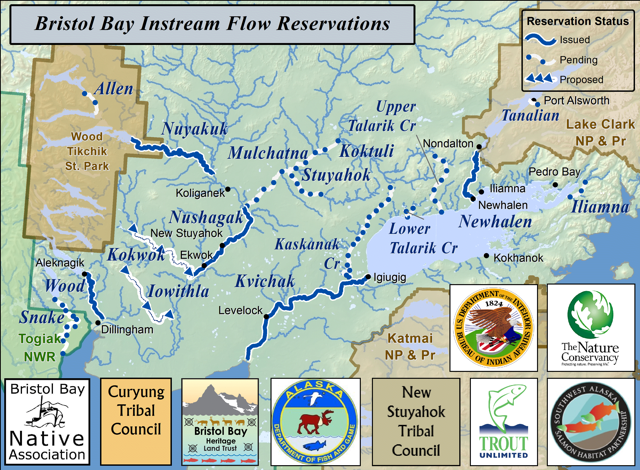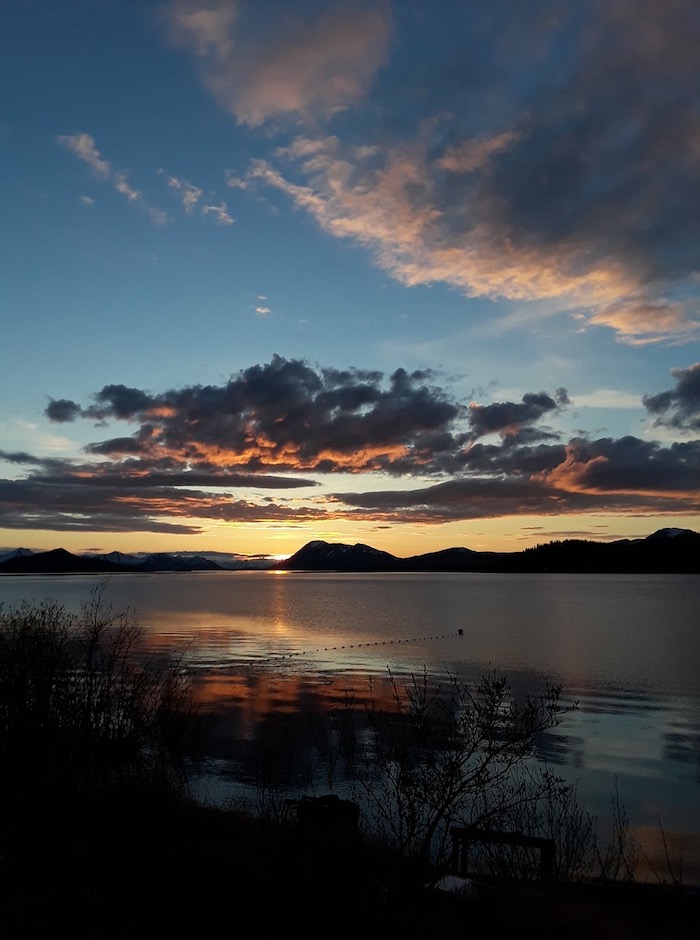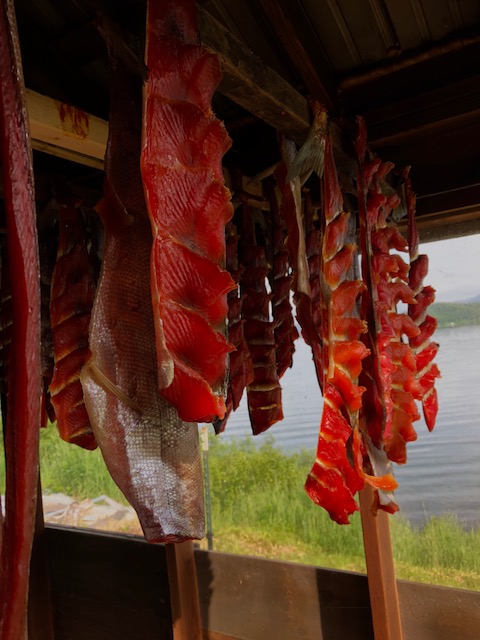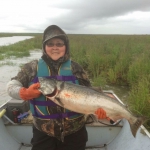By: Helen M. Aderman, Marine Mammal Program Manager, Bristol Bay Native Association & 2019 ARCUS Arctic Indigenous Scholar
The recommendation of the Bristol Bay Marine Mammal Council and Qayassiq Walrus Commission to federal and state agencies is to work together on establishing a permanent marine mammal habitat corridor in the Togiak Bay, Alaska area to protect the marine mammals, their habitat, and other species from the seasonal northern Bristol Bay yellowfin sole trawl fishery; and to have access on these waters every year from 1 April—15 August.

The proposed Pebble Mine is a threat to one of Bristol Bay tribal members' main staple—all salmon species in the freshwater watershed areas in the Iliamna Lake communities extending to the Bristol Bay oceans. Every spring, the juvenile smolts start their out-migration from their freshwater habitats into the ocean waters. There is a transition period, for one to two weeks, when the smolts go out to the Bay's ocean water's edge to get acclimated to the colder ocean waters, and go back into the freshwater system until they are fully prepared to live in the ocean waters for one to two years. After a few years in the ocean environment, they travel back up through rivers, creeks, and streams into the freshwater lake systems to where they were born to spawn out. After the salmon have laid their eggs in stream and creek beds, the cycle of life starts again with new birth and new life.


If there are heavy early spring and late fall rainfalls, the streams and creeks become at least 2–4 feet wider. This results in an increased flow downstream, which affects the salmon egg habitat, as well as the newly born juvenile salmon species. From Talarik and Koktuli creeks, the heavy current flowing from the proposed Pebble Mine toxic tailings can result in destroying the fragile fish and waterfowl habitat areas, including tundra forage foods for large land animals and fur bearing animals.
For years, the Qayassiq Walrus Commission (QWC) and the Bristol Bay Marine Mammal Council have worked with the U.S. Fish and Wildlife Service and the National Marine Fisheries Service in establishing long-term marine mammal corridor boundaries of the shared marine subsistence food resources shared in Togiak Bay by all other Bristol Bay tribes. The U.S. Fish and Wildlife Service determined that there was no noise disturbance to establish long-term Round Island Protection corridor, but that the 3-mile no fly zone established by the North Pacific Fishery Management Council was sufficient to protect the walrus haulout at Round Island (Qayassiq). Since Walrus Islands is a State Game Sanctuary, the agencies claim the State owns the Walrus Islands, but our Yup'ik Eskimo Ancestors have always lived and hunted in the Togiak Bay area. This is a jurisdictional issue that needs to be resolved by all parties.
Not having a long-term inter-tribal relationship with the federal and state agencies has resulted in giving the seasonal yellowfin trawl fisheries more access on the Walrus Islands, except for the 3-mile Round Island walrus haulout protection zone. Since 1995, the seasonal yellowfin sole trawl fishery has impacted the traditional subsistence food harvests of Pacific walrus, clams, and bearded seals' habitat. It is a traditional known fact that there is a spring and fall migration of the marine mammals, and the seasonal yellowfin sole trawl fishery has diverted the spring migration of male Pacific walrus from the northern Bering sea to their historic Bristol Bay walrus haulouts: Round Island, Hagemeister Island, Cape Peirce, and Cape Seniavin. For the past three years, new walrus haulouts have emerged as a result of human disturbance of walrus in the Northern Alaska Peninsula in Cape Craig and in Meshik Bay, Alaska.
Recommendations in Establishing a Marine Mammal Protection Corridor
- Tribal consultation with the State of Alaska, National Marine Fisheries Service, and the U.S. Fish and Wildlife Service needs to occur to establish Togiak Bay Marine Mammal Protection Corridor so the Pacific walrus can return to their respective historical habitats, and the bearded seals, as well. Our Tribes were taught to conserve their traditional food resources for long-term food security purposes.
- Agencies who claim to water rights ownership need to take a second look and make some conclusions that there is Tribal Jurisdiction in Tribal waters due to historic access to their Ancestral Home communities: traditional subsistence resource camps and sacred Alaska Native historical places that will continue to provide safe, reliable access to their traditional marine ecosystem resources without fear of being arrested for "trespassing" on their own inherent Ancestral hunting grounds, lands, and waters.
Major Gap Analysis Need
We all recognize there are changes in our environment, including climate change, which is affecting our tribal food security year-round cycle of harvesting our traditional species resources and their habitat areas. There is a gap in the statewide Alaska Native Organization (ANO) Marine Mammal Management, Research, and Monitor funding. Not all ANOs receive marine mammal co-management funding, although we have the infrastructure and full capacity to manage our own region's resources with respective tribal members. We need full funding for staff salaries, travel, board meetings, and marine mammal tribal capacity to build integrated research projects and long-term marine mammal monitoring projects, including: (1) Consensus building among Bristol Bay tribes; (2) Collaborative research and management of marine mammals; (3) Mentoring of a student intern to learn marine mammal management processes; (4) Develop tribal ordinances in managing tribal multi-species resources for the five Bristol Bay sub-regional communities; (5) Develop tribal regional marine multi-species conservation plans in Perryville, Igiugig, Manokotak, Naknek, and Newhalen; and (6) Develop a regional marine Mammal Multi-Species Management Plan and Research Plan.
About the Author
 Helen Kegginarrluk Aderman is Yup'ik born in Togiak, Alaska, from Aleknagik, Alaska. She is the Bristol Bay Native Association's Marine Mammal Manager, based in Dillingham, and the Executive Director of the Qayassiq Walrus Commission and Bristol Bay Marine Mammal Council. She holds a B.A. in Rural Development from University of Alaska Fairbanks. Helen is working to address impacts on marine mammal habitat use areas and to ensure future Alaska Native generations will have continued access to their traditional marine foods for harvest.
Helen Kegginarrluk Aderman is Yup'ik born in Togiak, Alaska, from Aleknagik, Alaska. She is the Bristol Bay Native Association's Marine Mammal Manager, based in Dillingham, and the Executive Director of the Qayassiq Walrus Commission and Bristol Bay Marine Mammal Council. She holds a B.A. in Rural Development from University of Alaska Fairbanks. Helen is working to address impacts on marine mammal habitat use areas and to ensure future Alaska Native generations will have continued access to their traditional marine foods for harvest.
